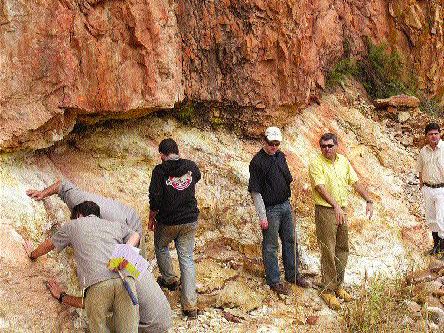Teofilandia, Brazil — When
The big company was Brazilian iron ore and base metal giant
Fast forward to the late 1990s, though, and the gold industry was not nearly as congenial. Prices had slumped, and several big base metal companies had either spun off or sold their gold interests, creating companies like
CVRD found itself in the same predicament as many other majors, complicated further by its own privatization. In 2003, it sold Fazenda Brasileiro to Yamana, a Canadian-based junior that had been purpose-rebuilt from an earlier Argentine focus to take on Brazilian gold projects.
What Yamana found was a good mine that had suffered from an indifference to gold mining that had been forced on CVRD by weak prices and other corporate priorities. CVRD had started underground mining in 1988, and Fazenda Brasileiro had evolved from a pit-and-heap operation into a classic underground mine. The “system,” though, had not evolved with it, and the attention to detail that is the mark of successful underground operations was not possible under the large-company umbrella.
Yamana hopes to change that, with some money and a generous helping of empowerment. It inherited the CVRD staff, mining men with experience and enthusiasm, and building on that base it has seen steady improvements in the mine’s performance.
Two striking features underground at Fazenda Brazileiro are its highly silicified, competent rock, and its lack of water. Both simplify the mining process, allowing sublevel stoping and needing a minimum of intervention for ground control.
Still, there was room for improvement when Yamana took over — for example, in the routine production drilling. Previous operators had drilled production holes downward, essentially blind to the mineralized zone. Simply switching to upward fan drilling in stopes, from sublevels below the orebody, allows crews to sample the ore face on the stope back, which permits better grade control.
There were fixes above ground too, and many simply came about by having a staff with the mandate to take a fresh look at the way things were done. An updated control system in the mill allows the great majority of mill functions to be controlled by one worker from a set of computer workstations in the control room.
In maintenance, too, there has been a significant change, which Yamana staff credit to the adoption of International Standardization Organization management systems. “It was good to change the culture,” says maintenance manager Carlos Cruz. “This idea is growing in the heads of the workers.”
Equipment is now more widely seen as an asset that needs to be protected, and work schedules and patterns that allow equipment to be pulled out of service for regular maintenance have increased the availability of the mining fleet.
And the workforce has become more conscious of another asset that needs to be protected — themselves. CVRD can take some of the credit, as it brought a high accident rate down significantly between 1999 and 2003. Yamana’s accident rate has stayed down, with the mine’s accident-severity rate (the time lost to accidents, normalized for the number of working hours at the mine) decreasing.
This has also translated into a better mine on the quarterly financial statements. When CVRD turned over the mine to Yamana, the big company had cash production costs of US$268 per oz., with another US$7 added for corporate costs. Yamana brought that number down to US$216 in its first six months, and most recently reported US$213 per oz. for the quarter ended March 31.
Having the mine ticking over well in the present allows Yamana to think in more detail about the future. CVRD’s exit from the gold business, even though it may have held the operation back in the past, supplies an opportunity: the company had no reason to put good money into gold exploration at Fazenda Brasileiro, so “there’s very good potential for improving reserves,” says Dan Kivari, a Yamana project manager.
If Yamana can put together enough new reserves, which would be carried mainly on the back of the mine’s E-zone deep mineralization, then a US$2.5-million shaft deepening program could go ahead. The existing hoist can handle the job down to about 800 metres below surface, and a new shaft could be raise-bored from the 800-metre level up to the existing shaft base at 400 metres.
Conveniently, the shaft is in the hanging wall of the ore deposit, so at depth the ore would require less hauling, not more. Shallow-dipping orebodies, like Fazenda Brasileiro, can rapidly get out of reach of a footwall production shaft as mining goes deeper.
Reserves at the mine stood at 2.5 million tonnes grading 3.2 grams gold per tonne at Yamana’s February 2004 year-end. That offers a mine life of four years at current production rates, but deep E-zone mineralization — which has a significantly higher grade than the material currently being mined — has not been brought into reserves.
An ongoing drilling program on the near-surface C-Quartz zone near the shaft has indicated previously unknown mineralization, mainly at 50- to 80-metre vertical depths, along a 425-metre strike length. Bringing that material into resources or reserves would have no impact on the shaft decision, but it does provide an insight into the exploration potential at the mine itself. Grades in seven recent holes ranged from 1.4 to 10.6 grams gold per tonne, over widths of 2-8.5 metres; some high-grade zones carried much higher gold grades, including an 8-metre intersection running 23.8 grams and a 4-metre intersection running 101.7 grams per tonne.
More ore would be nice, and that goal seems to be reachable. In gold mining, the right people and a little empowerment go a long way.


Be the first to comment on "Fazenda Brasileiro a success for Yamana"